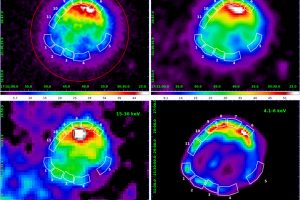Different regimes of particle acceleration in supernova remnants. The study: “A Spatially Resolved Study of Hard X-Ray Emission in Kepler’s Supernova Remnant: Indications of Different Regimes of Particle Acceleration” of V. Sapienza (UNIPA/OAPA) appeared on ApJ

Cosmic rays are high-energy charged particles which continuously hit our planet. These particles are accelerated up to such high velocities in different astronomical environments, among which supernova remnants seems to be particularly important. These objects are nebulae in rapid expansion generated by the explosions of very massive stars. In supernova remnants, particle acceleration seems to occurr along the expanding shock generated by the supernova, with a process called “diffusive shock acceleration“. Shortly, particles acquire energy being reflected multiple times by the magnetic fields along the shock.
The role of supernova remnants in the acceleration of cosmic rays is supported by observations in the X-rays and gamma rays. In particular, because part of the emission in these bands observed in the remnants is due to higly energetic particles moving in magnetic fields (synchrotron non thermal emission). In a given supernova remnant, particle can be accelerated in different regimes, resulting in different properties of the observed non thermal emission. One of the parameters that may change is, for instance, the energy threshold that particles can reach, which in turns affects the spectrum (e.g. the distribution of energy) of the observed radiation. This threshold may be affected both by the energy loss by radiation (loss-limited scenario) and the time available for the acceleration (time-limited scenario). The analysis of the non-thermal component of the energetic radiation observed in supernova remnants, for instance by measuring the timescale of energetic loss of the synchrotron emission (which is defined as the time necessary for energetic particles to loose 50% of their initial energy), can allow astronomers to discern between these scenarios.
Kepler supernova remnant is one of those objects from which non thermal emission from high-energy electrons was detected. This supernova remnant has an almost spherical shape, with some ongoing interaction between the expanding remnant and a pre-existent cloud of insterstellar medium occurring in the northern part. The team led by V. Sapienza (University of Palermo and INAF – Astronomical Observatory of Palermo) analyzed X-ray observations of this remnant acquired with the NASA telescope NuSTAR and the ESA telescope XMM/Newton, with the aim of study its non-thermal emission. The authors defined a set of regions along the shock of the remnant, and in each of these regions they have analyzed the spectral properties of the X-ray emission and thus the process of particle acceleration. This analysis shows the presence of two different regimes of particle acceleration in this remnant, which is more efficient in the northern part, where the shock is interacting with the interstellar medium, than in the southern part. The authors suggest that this is the consequence of the interaction between the shock and the surrounding cloud, which results in a more intense and turbulent magnetic field. The study is described in the paper: “A Spatially Resolved Study of Hard X-Ray Emission in Kepler’s Supernova Remnant: Indications of Different Regimes of Particle Acceleration“, recently appeared on The Astrophysical Journal. The coauthors list counts astronomers of the Univerisities of Tokyo and Saitama, togheter with M. Miceli and G. Peres of the University of Palermo, and F. Bocchino and S. Orlando of INAF – Astronomical Observatory of Palermo.
The image (click here to visualize the entire figure) shows the X-ray images of the Kepler supernova remnant in four different energy bands. The red circles delimits the area from which the total X-ray spectrum of the remnant has been extracted. The cyan circle, instead, delimits an area characterised by very energetic X-ray emission. The white polygons delimit the areas analyzed in this paper.
Mario Giuseppe Guarcello ( follow mguarce) ( youtube)
Follow the Astronomical Observatory of Palermo on Facebok
Subscribe the Youtube channel of the Astronomical Observatory of Palermo
